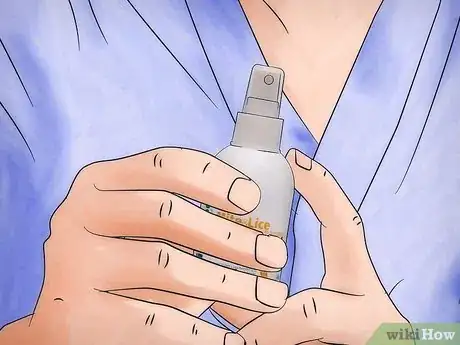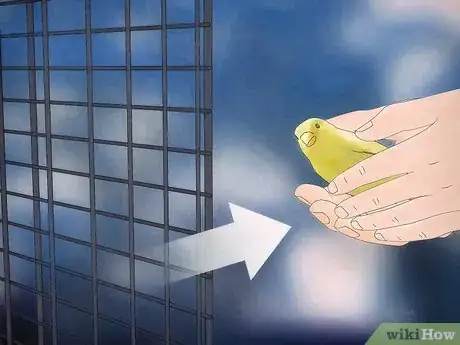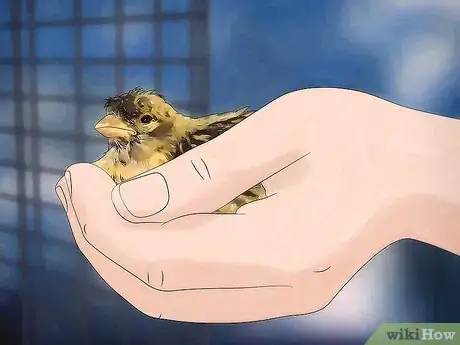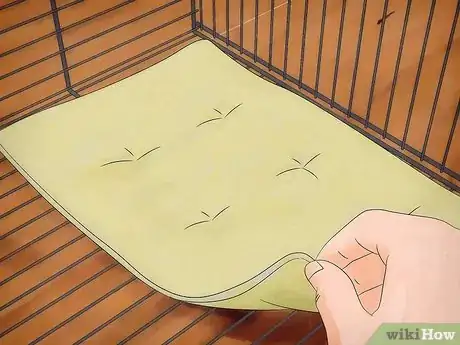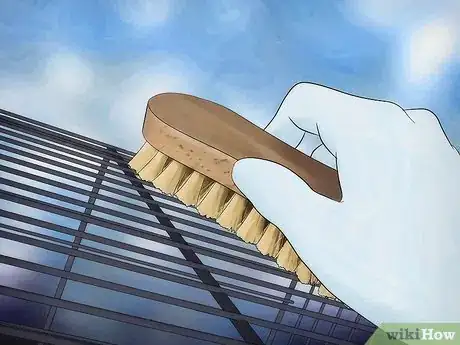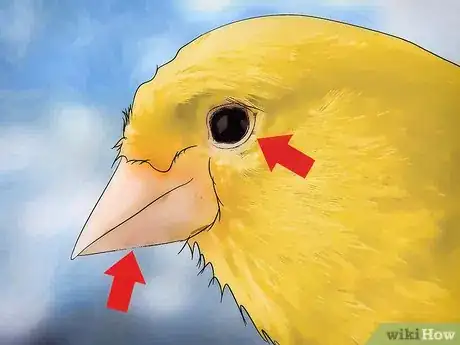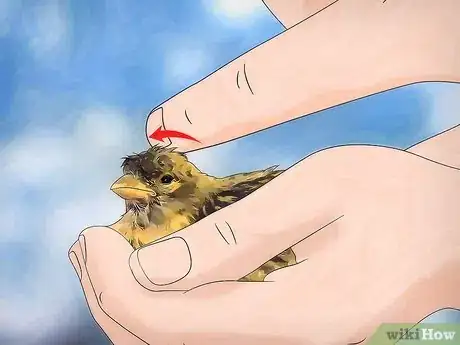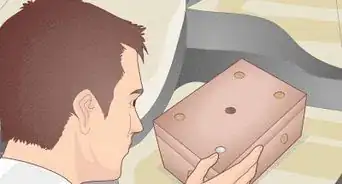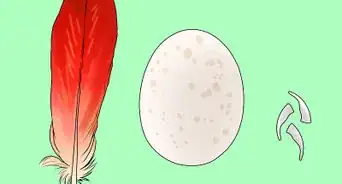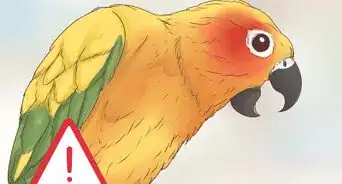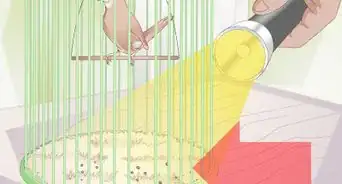This article was co-authored by Pippa Elliott, MRCVS. Dr. Elliott, BVMS, MRCVS is a veterinarian with over 30 years of experience in veterinary surgery and companion animal practice. She graduated from the University of Glasgow in 1987 with a degree in veterinary medicine and surgery. She has worked at the same animal clinic in her hometown for over 20 years.
There are 8 references cited in this article, which can be found at the bottom of the page.
wikiHow marks an article as reader-approved once it receives enough positive feedback. In this case, 93% of readers who voted found the article helpful, earning it our reader-approved status.
This article has been viewed 67,723 times.
The blood mite (also known as the red mite) is a nasty bird parasite that can ruin life for your canaries, especially for canary nestlings. These mites are nearly invisible to the human eye. During the day, they will hide in the cracks of a cage, aviary, or bird shelter. At night, they will emerge and suck the blood of canary nestlings and mothers. They will return to their hiding holes before the light of day appears. Keep the mites at bay, and your canaries will be much healthier and happier.
Steps
Treating Your Canary
-
1Take your bird to the vet. It may be tempting to take the canary back to the pet store where you bought it, but there is a chance that the employees will not be able to correctly recommend a good treatment.[1] If you find that you have an infestation, take your bird to the vet. The vet can correctly diagnose the type of mite and provide advice on proper treatments.
- While your local vet may be able to handle birds, it is best to find an avian or exotic pet veterinarian.[2]
-
2Use a bird-safe insecticide. Many common insecticides can harm your bird. Ask your vet for an insecticide that is safe for your canary. There are many brands available that are designed specifically for use on birds with mites. Follow the dosage instructions on the product or ask your vet for advice on how much and how often to spray. Carefully apply around the plumage, and spray the insecticide into the dark corners of the bird house.[3]
- Ivermectin is an ingredient that can kill lice and mites. You can find low concentrations of it for birds at your local pet store.[4] You can also check for lice and mite medications that contain it as an ingredient.
- Permethrin is another common type of insecticide used to kill red mite and lice in birds.
- These sprays typically do not kill mite eggs. You will have to clean the cage thoroughly to destroy the mite eggs.
Advertisement -
3Move the birds from their cage. It is hard to treat the birds when there are hundreds or thousands of mites crawling around in their cages. Even if you kill all of the mites on the bird, they can be re-infected overnight. Spray a clean cage with insecticide, and lay down fresh shavings. After you have applied the insecticide, relocate your birds temporarily this accommodation. You may chose to place a paper towel on the bottom of this cage to catch any dead mites that are dropping off your bird. Replace this towel often.[5]
-
4Remove babies from the nesting box. Young birds are especially vulnerable to the mites, and you should treat them separately from the adults. The older birds may pluck out the chicks' feathers in an attempt to remove the mites. Carefully remove nestlings from the infested nesting box. Treat them with a safe insecticide spray. Keep them in a clean nesting box separate from the adults with a lining of paper towels. Change out the paper towels every ten minutes at first, then every thirty minutes, and then every hour. The mites should fall off the baby birds after they feed, and you can remove the mite-infested towels. Keep changing the towels until no more mites fall off.[6]
- Be sure to treat their new nesting box beforehand with insecticide.
- Once both the adults and the babies have been fully deloused, you can reintroduce the chicks to the adult cage.
Cleaning the Cage
-
1Empty the cage. Toss out all padding and bedding in the cage. Remove as many separate parts of the housing as you can. You will be cleaning these separately. Since mites like to crawl around in the small nooks of the cage, you will more successfully eliminate the infestation by dismantling the cage and cleaning each part separately.[7]
-
2Wash each part of the cage. Dilute 1/4 cup of bleach in a gallon of warm water. Wear gloves as you scrub down each part of your bird’s housing or cage. Rinse afterwards with fresh water.[8] Alternatively, if you have access to a power washer, you can spray down each part.
- Don’t neglect the small cracks and grooves. These are where mites like to live. Scrub down into these parts.
-
3Spray the aviary down with an insecticide. Use an insecticide that is safe for birds. You can use the same spray you used on your bird. Spray down each part individually, and make sure that it reaches the dark cracks and holes.
-
4Leave the cage outside to dry. You can leave the cage outside to dry for a day or two. After it is dry, check it over carefully for any more signs of mites. Do not place the birds into this cage until they have been fully treated for the mites living in their feathers, or you will risk starting another infestation.
-
5Fill in any nooks and crannies where mites can reside. This may be a small or a large job, depending on the size of your canaries' home, but it is very important to prevent future infestations. Use gap filling agents or sand down these areas. Paint with bird-safe paint once you have finished.
-
6Return the birds to their cage. Once you are certain that the infestation has been completely eliminated, you can return the birds back to their original cage. Wait until you are certain that all of the mites on the bird have been treated; this may take up to a week. Once you have returned the canaries to their original cage, clean the secondary cage in the same manner to fully ensure that all of the mites have been killed.
Diagnosing Your Canary
-
1Note any unusual symptoms. Canaries suffering from blood mites may have powdery lesions around the face, beak, or eyes. Other symptoms include weakness, lack of appetite, or lack of energy. Be on your guard if your canary seems to be sleeping more than usual.[9]
-
2Check the crest of the bird. This type of mite in particular can usually be found on the head and around the crest of the bird. With your fingers, gently brush the feathers around the head of your canary. The mites will appear as small red specks. After a few seconds, the specks may move and disappear into the feathers. The mites are small, so look carefully.[10]
-
3Place a white cloth in the cage. If you are concerned that mites have moved into the cage, you can try using a white cloth. Fold the cloth so that it fits in the cage, and place it on the bottom. Leave it there overnight. In the morning, if you see any small red specks on the cloth, you may have an infestation.[11]
-
4Examine the cage. If you don’t see mites on your birds but suspect there might be an infestation, examine the cage closely, especially the nesting box. Blood mites like dark spots and are often found in the cracks and bedding of the cage. Use a flashlight to shine into these dark areas. You may see hundreds of tiny specks milling about in these spots.[12]
Warnings
- Mites carry diseases, such as atoxoplasmosis, which is passed from one bird to another. Getting rid of the mites is the best way to keep all your canaries healthy.⧼thumbs_response⧽
- If you are noticing that your bird is making clicking noises as they breathe or you notice dark granule shapes in their throats, they may have air sac mites instead of blood mites.[13] These are another common type of mite in canaries, but they require different treatment. Seek a vet’s advice immediately.⧼thumbs_response⧽
References
- ↑ https://www.beautyofbirds.com/sickbirdcare.html
- ↑ http://www.petuniversity.com/birds/canaries-finches/health-canaries-finches.htm
- ↑ http://www.canaryadvisor.com/red-mites.html
- ↑ https://www.tandfonline.com/doi/pdf/10.1080/03079459708419205
- ↑ https://www.beautyofbirds.com/mites.html
- ↑ https://www.beautyofbirds.com/mites.html
- ↑ https://poultrykeeper.com/blog/how-to-get-rid-of-red-mite/
- ↑ http://www.prettybirds.net/FAQ.html
- ↑ http://www.canaryadvisor.com/canary-disease.html
About This Article
If you've noticed symptoms of blood mites in your canary, like powdery lesions on its face or beak, small red specks on its head, and lethargy, take it to the vet for a diagnosis. Once you know you’re dealing with blood mites, get a bird-safe insecticide to apply to your canary’s plumage and cage to kill the mites. After treating your canary, you’ll need to thoroughly clean its cage to not only kill any remaining mites but also get rid of any mite eggs. In order to wash the cage, dilute ¼ cup of bleach in a gallon of warm water and scrub down each part of its housing, then rinse it with clean water. For more tips from our Veterinary co-author, including how to use a white cloth to tell if your canary has mites, keep reading!

